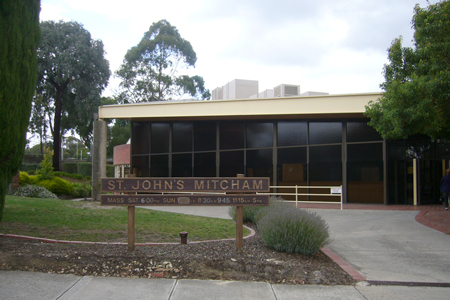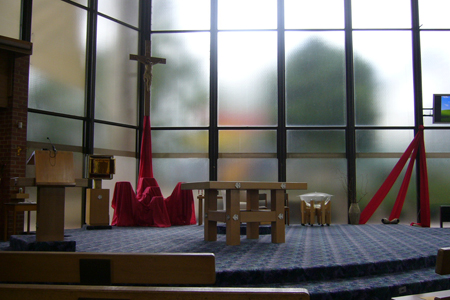| |
 |
 |
 |
| Comment on this report, or find other reports. |
 |
| Our Mystery Worshippers are volunteers who warm church pews for us around the world. If you'd like to become a Mystery Worshipper, start here. |
 |
| Find out how to reproduce this report in your church magazine or website. |
|
|
| 1918: St John
the Evangelist, Mitcham, Victoria, Australia |
 |
 |
 |
Mystery Worshipper:
Queenie.
The church:
St
John the Evangelist, Mitcham, Victoria, Australia.
Denomination:
Roman Catholic, Archdiocese
of Melbourne.
The building:
The building is fairly nondescript from the outside, but the
internal worship space is quite striking. As you enter from
the rear of the church, all the architecture points to the cross.
The ceiling rises up from either side of you toward an apex
above the cross. The windows form a triangle, from a low point
at the extreme left and right of the church to its highest point,
also above the cross. There is plenty of light inside the building.
The sanctuary seems to take up a large proportion of the floor
space, giving it an open, uncluttered feel.
The church:
The parish has two centres: St John's Mitcham, and St James'
Vermont, both of which have their own primary schools. It is
a large and vibrant community, with many social, sporting and
spiritual groups available, and with pastoral and outreach services
to people of all ages, cultures and conditions.
The neighbourhood:
Mitcham is in the eastern suburbs of Melbourne, about 20km from
the central business district. From its settlement in the 1860s,
the Mitcham area was generally used for orchards, brickmaking
and pottery. In the 1950s post-war expansion, it became the
suburban area it is now. Mitcham is well serviced by the train
line that runs through it, numerous bus routes, and the freeways
that bound its northern and eastern edges. Mitcham has several
significant parklands and numerous schools, making it attractive
to families. And a piece of trivia: Mitcham was a filming location
for the world's first feature film, The Story of The Kelly
Gang, which used the area in key scenes for the 1906 movie.
The cast:
The service largely ran itself! The whole thing was so well
scripted that everyone who had anything to say or play knew
exactly what they had to do and when. The parish priest, the
Revd Mark Reynolds, played his part, much of that being the
still centre of the service that largely went on around him.
The date & time:
Good Friday, 2 April 2010, 3.00pm.
What was the name of the service?
Commemoration of the Passion.
How full was the building?
Overflowing. The church seats about 500. I had been warned to
arrive early, as this service is always well-attended. I arrived
at 2.30pm and there were already over 100 people there. By 2.45
the seating was full, and people were standing around the back
walls of the church. There was also seating in the narthex,
where there were video screens to watch the service. At a guess,
there would have been 700 people in attendance.
Did anyone welcome you personally?
There was no one welcoming people at the door when I arrived
but, as I said, I was very early. When I sat down, I was introduced
to the people on either side of me. There is a welcome desk
inside the narthex, but this was unattended. There were several
ladies showing people to the vacant seats. There were no books
or leaflets handed out.
Was your pew comfortable?
Well, for a wooden pew, it was comfortable. We were all packed
in quite snugly!
How would you describe
the pre-service atmosphere?
As the church filled, the volume of chatter increased, but not
to an unreasonable level. There was a sense that people were
happy to be together, and there was an air of anticipation.
At 2.55, a pastoral associate, Maree O'Keefe, welcomed us, asked
us to turn off our mobile phones, and asked us all to read the
part of the crowd during the passion narrative. She then reminded
us that this was a service of prayer, not a concert, and that
we were not to applaud any of the music items. (This had apparently
been an awkward occurrence in the past few years.)
What were the exact opening
words of the service?
At 3.00, the music group started playing a gentle Taize chant,
"Adoramus te Domine" ("We adore you, Lord Jesus Christ"). During
this time, Father Reynolds entered the church and prostrated
himself on the steps of the sanctuary, in front of the altar
and the cross. He stayed there for the duration of the singing.
After this, he stood, invited us to stand, and opened with the
words: "Now the hour has come for the Son of Man to be glorified."
What books did the congregation use during the
service?
There were no books used during the service. The whole order
of service seemed to be known by the congregation. The words
of the songs were on digital screens mounted on the walls at
three points inside the worship space. These were quite discrete,
with the background of the lyrics coloured red to match the
decorations in the church. I found it easy to read, sitting
only three rows from the front, but wondered if the words would
have been too small to be read by those in the tenth row, and
those standing behind them.
What musical instruments were played?
There was an electronic keyboard (playing a nice piano sound), two acoustic guitars, and an electric bass guitar. There was also a choir to lead the singing, made up of people of all ages.

Did anything distract you?
Ironically, I was most distracted by the thing that was probably
designed to not distract me. The passion narrative and the intercessions
were read by people sitting in the front pews on the other side
of the church from me. The microphones were excellent, and I
could hear them perfectly. I just found it very distracting
that I could not see the people who were speaking! It was like
disembodied voices. I'm sure that this was meant to save me
the distraction of watching the people who were reading, but
as a visitor, I found it having the opposite effect on me.
Was the worship stiff-upper-lip, happy clappy, or
what?
The worship was meditative and gentle. It was woven throughout
the service, with verses and choruses breaking up the reading
of the passion narrative. This kept the overall mood lighter
than it often is on Good Friday.
Exactly how long was the sermon?
8 minutes.
On a scale of 1-10, how good was the preacher?
9 – A very inspiring and well delivered message.
In a nutshell, what was the sermon
about?
Father Mark asked us the question Jesus had asked prior to his
arrest: "Whom are you looking for?" He asked why we had come
to church today and suggested that while it might seem like
we come to mourn, in fact we come just to stop. He reminded
us that at churches all around Melbourne, people were attending
to stop and to be amazed. Jesus is not just anyone. It is Jesus
who meets us in our pain, brokenness and despair. Through his
Son, God is present with us in the darkness of our lives. When
we are most lost and broken, the Son of God is there with us.
God meets us at our most basic. On Good Friday, the message
is that, whatever comes our way, we are not alone. We also know
that this is not the end of the story. Come what may, and despite
it all, thank God for Good Friday.
Which part of the service was like being in
heaven?
It was no mean feat giving communion (bread only) to about 700
people, but they did it with a minimum of fuss, from seven different
points. Once I sat back down and watched everyone else going
up for communion, I had an overwhelming sense that I was watching
a multitude walking together into heaven. Among the people were
the blind and the lame, and people from every continent on earth.
I felt like I was watching an endless stream of people coming
into the presence of a God with whom they were very familiar,
and whom they adored.
And which part was like being in... er... the other place?
You know, the whole service was done so seamlessly that the
most difficult thing to deal with was my own cynicism. I wanted
to argue any number of things that all came from my own prejudices.
In the end, however, I came to the realisation that these thoughts
of mine were the only hellish part of the service. My eyes and
ears told me that this was a group of people who were just happy
to be together to commemorate this special day. Everyone knew
the lyrics to the songs, the words of the service, when to sit
and and kneel and rise. It was an example of a people praying
the service together, as one body. The parts of me that wanted
to detract from that need to undergo their own death and Easter
rebirth.
What happened when you hung around after the service looking lost?
At the end of the service, doors were opened in places I hadn't
realised there were external doors! The church emptied very
quickly, and people went home. There were a few people who stopped
and waited for their turn to speak with Father Mark. Given that
this was the Good Friday service, however, it seemed appropriate
that people left in the same relative quiet with which they
had arrived.
How would you describe the after-service
coffee?
From what I could tell, there were no refreshments offered after the service.
How would you feel about making this church your regular (where 10 = ecstatic, 0 = terminal)?
9 – If I were Roman Catholic, I would have no hesitation
in making this my spiritual home. As an Anglican, I would be
happy to come back each year for this service. It was a beautiful,
gentle journey to the cross.
Did the service make you
feel glad to be a Christian?
Yes, it did. But part of me thinks that there is an obligation
on the part of those running such a service to have something
that will induce tears. I have mixed feelings about the comparative
lightness of the mood in the church. I wonder if that is part
of the secret to getting so many people to church on Good Friday:
making it less gut-wrenching and, well, more able to be incorporated
into daily living.
What one thing will you
remember about all this in seven days' time?
The chorus that we sang at the beginning and the end of the
service, and at various points during the Passion narrative.
The song was, "Now we remain" by David Haas. I don't think that
the lyrics have finished working their magic on me yet, and
I think I need to sit with them for a while. The chorus went
like this: "We hold the death of the Lord deep in our hearts.
Living now we remain with Jesus, the Christ." |
|
|
 |
 |
 |
| We rely on voluntary donations to stay online. If you're a regular visitor to Ship of Fools, please consider supporting us. |
 |
 |
 |
| The Mystery Pilgrim |
 |
| One of our most seasoned reporters makes the Camino pilgrimage to Santiago de Compostela in Spain. Read here. |
 |
 |
 |
| London churches |
 |
| Read reports from 70 London churches, visited by a small army of Mystery Worshippers on one single Sunday. Read here. |
| |
|
|
|
|


